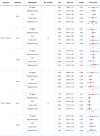No genetic causal association between human papillomavirus and lung cancer risk: a bidirectional two-sample Mendelian randomization analysis
- PMID: 39227966
- PMCID: PMC11373185
- DOI: 10.1186/s13063-024-08366-5
No genetic causal association between human papillomavirus and lung cancer risk: a bidirectional two-sample Mendelian randomization analysis
Abstract
Introduction: Several observational or retrospective studies have previously been conducted to explore the possible association between lung cancer and human papillomavirus (HPV) infection. However, there may be inconsistencies in the data and conclusions due to differences in study design and HPV testing methods. There are currently no studies that provide conclusive evidence to support the involvement of HPV in the occurrence and development of lung cancer. Therefore, the relationship between HPV and lung cancer remains controversial and uncertain. This study aimed to explore whether HPV infection is causally related to lung cancer risk by systematically performing a two-way Two-Sample Mendelian Randomization (TSMR) analysis.
Methods: In the International Lung Cancer Consortium (ILCCO) genome-wide association study dataset, we included 11,348 lung cancer (LUCA) cases, including 3275 squamous cell carcinoma (LUSC) cases, 3442 adenocarcinoma (LUAD) cases, and 15,861 cases of control. Using genetic variants associated with the HPV E7 protein as instrumental variables, we summarized statistics associated with HPV infection in the MRC IEU OpenGWAS database, which included the HPV-16 E7 protein and the HPV-18 E7 protein. Two-sample Mendelian randomization (MR) results are expressed as odds ratios (OR) and 95% confidence intervals (CI).
Results: Based on a comprehensive analysis of genome-wide association study (GWAS) data from public databases, we mainly used inverse-variance weighted (IVW) to estimate causal relationships, while using MR-Egger, weighted median, simple mode, and weighted mode, and other four methods as supplements. Two-sample MR Analysis revealed no causal relationship between exposure factors (HPV-16 E7 protein and HPV-18 E7 protein) and outcome factors (lung cancer (LUCA) and its subtypes squamous cell carcinoma (LUSC) and adenocarcinoma (LUAD)) in forward MR Analysis using the IVW approach.HPV-16 E7 protein and LUCA and its subtypes LUSC and LUAD by IVW method results: [OR] = 1.002; 95% [CI]: 0.961 - 1.045; p = 0.920; [OR] = 1.023; 95% [CI]: 0.966 - 1.084; p = 0.438; [OR] = 0.994; 95% [CI]: 0.927 - 1.066; p = 0.872); HPV-18 E7 protein and LUCA and its subtypes LUSC and LUAD by IVW method results: [OR] = 0.965; 95% [CI]: 0.914 - 1.019; p = 0.197; [OR] = 0.933; 95% [CI]: 0.834 - 1.043; p = 0.222; [OR] = 1.028; 95% [CI]: 0.945 - 1.118; p = 0.524. It was observed through reverse MR that LUCA and its subtypes LUSC and LUAD were used as exposure factors, and HPV infection (HPV-16 E7 protein and HPV-18 E7 protein) was used as the outcome factors, the results of the IVW method are also invalid.LUCA and HPV-16 E7 protein and HPV-18 E7 protein by IVW method results: [OR] = 1.036; 95% [CI]: 0.761 - 1.411; p = 0.82; [OR] = 1.318; 95% [CI]: 0.949 - 1.830; p = 0.099; LUSC and HPV-16 E7 protein and HPV-18 E7 protein by IVW method results: [OR] = 1.123; 95% [CI]0.847 - 1.489; p = 0.421; [OR] = 0.931; 95% [CI]: 0.660 - 1.313; p = 0.682; LUAD and HPV-16 E7 protein and HPV-18 E7 protein by IVW method results: [OR] = 1.182; 95% [CI] 0.983 - 1.421; p = 0.075; [OR] = 1.017; 95% [CI]: 0.817 - 1.267; p = 0.877.Our results indicate that there is no causal relationship between genetically predicted HPV infection and LUCA and its subtypes LUSC and LUAD. In addition, in the reverse MR analysis, we did not observe a significant causal relationship between LUCA and its subtypes LUSC and LUAD on HPV infection.
Conclusions: Our findings do not support a genetic association between HPV infection and lung cancer.
Keywords: Causal relationship; HPV infection; Human papillomavirus; Lung adenocarcinoma; Lung cancer; Lung squamous cell carcinoma; Mendelian randomization.
© 2024. The Author(s).
Conflict of interest statement
The authors declare that there are no competing interests that could influence the results and conclusions of this study.
Figures






Similar articles
-
The association between human papillomavirus and lung cancer: A Mendelian randomization study.Infect Genet Evol. 2024 Sep;123:105646. doi: 10.1016/j.meegid.2024.105646. Epub 2024 Jul 24. Infect Genet Evol. 2024. PMID: 39059733
-
Causal relationship between gut microbiota and lung squamous cell carcinoma: a bidirectional two-sample Mendelian randomization study.Postgrad Med J. 2025 May 18;101(1196):526-534. doi: 10.1093/postmj/qgae184. Postgrad Med J. 2025. PMID: 39690971
-
Coronary atherosclerosis has a protective genetic causal effect against lung squamous cell carcinoma: A bidirectional two-sample Mendelian randomization study based on STROBE-MR guidelines.Medicine (Baltimore). 2025 Jul 25;104(30):e43378. doi: 10.1097/MD.0000000000043378. Medicine (Baltimore). 2025. PMID: 40725974 Free PMC article.
-
Mendelian randomization of individual sleep traits associated with major depressive disorder.J Affect Disord. 2024 Nov 15;365:105-111. doi: 10.1016/j.jad.2024.08.068. Epub 2024 Aug 15. J Affect Disord. 2024. PMID: 39153551 Review.
-
Causal relationship between genetically predicted uterine leiomyoma and cancer risk: a two-sample Mendelian randomization.Front Endocrinol (Lausanne). 2024 Aug 29;15:1429165. doi: 10.3389/fendo.2024.1429165. eCollection 2024. Front Endocrinol (Lausanne). 2024. PMID: 39268242 Free PMC article.
Cited by
-
A case of squamous cell carcinoma of the lung misdiagnosed as tuberculosis. Is HPV infected by oral sex the causative agent?BMC Womens Health. 2024 Oct 26;24(1):576. doi: 10.1186/s12905-024-03420-5. BMC Womens Health. 2024. PMID: 39462366 Free PMC article.
-
A Bidirectional Two-Sample Mendelian Randomization Study of Genetic Causality Between Vitamin D Levels and Pemphigus.Clin Cosmet Investig Dermatol. 2025 May 10;18:1167-1176. doi: 10.2147/CCID.S523136. eCollection 2025. Clin Cosmet Investig Dermatol. 2025. PMID: 40370580 Free PMC article.
References
-
- Shams-White MM, Brockton NT, Mitrou P, et al. Operationalizing the 2018 World Cancer Research Fund/American Institute for Cancer Research (WCRF/AICR) Cancer Prevention Recommendations: a standardized scoring system. Nutrients. 2019;11(7):1572. 10.3390/nu11071572. 10.3390/nu11071572 - DOI - PMC - PubMed
MeSH terms
Substances
LinkOut - more resources
Full Text Sources
Medical

